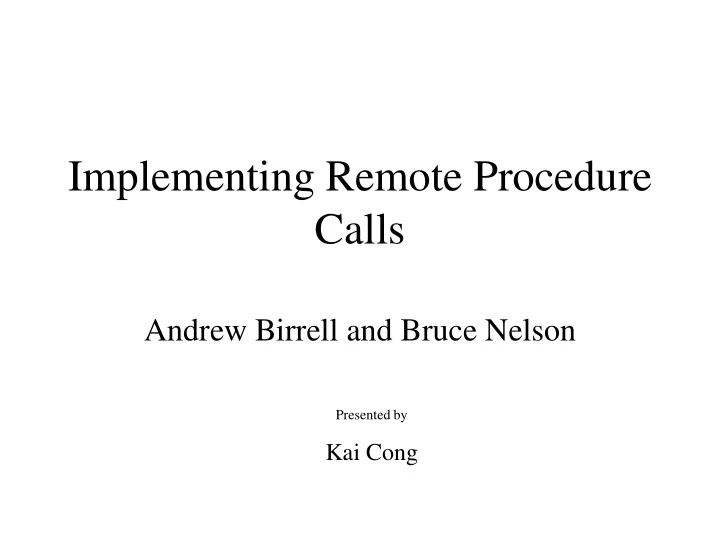

Implementing Remote Procedure Calls Andrew Birrell and Bruce Nelson Presented by Kai Cong
Conventional Procedure Calls main proc 1 proc 2 proc 3 proc 4 proc 5 proc 6 proc 7 proc 8 Within a program on a single computer!!!
Extension of the Procedural Model computer 1 computer 2 main proc 1 proc 2 proc 3 proc 4 proc 5 proc 6 proc 7 proc 8 across a netWork betWeen programs on different computers!!!
Remote Procedure Call (RPC) Client Server Blocked Blocked Computing Blocked 4
RPC – How it works client process server process client server RPC Runtime module RPC Runtime module procedure call procedure client stub server stub locate (un)marshal (un)marshal (de)serialize (de)serialize receive (send) send (receive)
Issues • Binding • Passing data • Implementation • Exceptions • RPC systems
Binding • The binding operation is to bind an importer of an interface to an exporter of an interface. • After binding, calls made by the importer invoke procedures implemented by the remote exporter. • static binding vs dynamic binding
Static Binding • static binding(not presented by the paper) – hard coded stub – simple – efficient – not flexible – stub recompilation is necessary if the location of the server changes – use of redundant servers is not possible
Dynamic Binding • dynamic binding – Interface: type and instance – Database • load balancing – flexible – redundant servers is possible
Dynamic Binding client process server process server client RPC Runtime module RPC Runtime module procedure procedure call 3 client stub server stub 7 1 7 bind register (un)marshal (un)marshal (de)serialize (de)serialize 4 find receive send send receive 5 6 2 Database
Issues • Binding • Passing data • Implementation • Exceptions • RPC systems
Passing Data • Can't use the stack! • Can't use shared memory! • Generally use message passing
Passing data Build a message that includes: • Who and what's being called • Identity of the caller • Data values in known byte order • Using an intermediate data representation
Issues • Binding • Passing data • Implementation • Exceptions • RPC systems
Implementation
Implementation • Function prototype is (almost) all that's needed to build the client stub – Also need binding information • Function prototype is (almost) all that's needed to build server stub – Also need method to wait for message
Implementation • Stub compiler – Generates stubs for client and server – Language dependent – Compile into machine-independent format • Transport protocol – PUP, XML, SOAP, DCOM, CORBA, …
Implementation Clients Servers Threaded Event Driven
Issues • Binding • Passing data • Implementation • Exceptions • RPC systems
Exceptions • What can happen in "normal" procedures ? – Procedure generates an exception – Procedure infinite loops – Procedure generates wrong results
Exceptions • What can happen in "remote" procedures? – Client stub generates an exception – Transmission failure knowable failure unknowable failure – Remote procedure generates an exception – Remote procedure infinite loops – Remote procedure generates wrong results
Issues • Binding • Passing data • Implementation • Exceptions • RPC systems
RPC Systems Sun RPC DCE RPC DCOM CORBA Java RMI XML RPC, SOAP/.NET, AJAX, REST Protocol Buffers (Google) Thrift (Facebook)
Conclusion • Remote Procedure Call should look and feel like local call • Remote Procedure Call should be independent of where it executes • Remote Procedure Call should be "efficient“
Recommend
More recommend